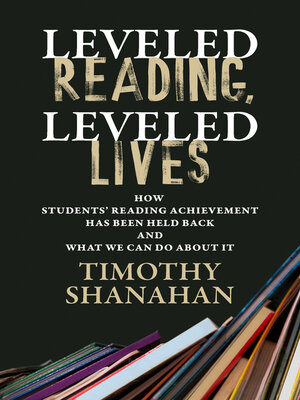Leveled Reading, Leveled Lives
ebook ∣ How Students' Reading Achievement Has Been Held Back and What We Can Do About It
By Timothy Shanahan

Sign up to save your library
With an OverDrive account, you can save your favorite libraries for at-a-glance information about availability. Find out more about OverDrive accounts.
Find this title in Libby, the library reading app by OverDrive.



Search for a digital library with this title
Title found at these libraries:
| Library Name | Distance |
|---|---|
| Loading... |
An engaging and evidence-based examination of how reading instruction has been misinterpreted and misapplied for decades and how to right the course to improve reading skills for all students
In Leveled Reading, Leveled Lives, leading literacy expert Timothy Shanahan curates a lively tour of the history of reading instruction in the United States, arguing that the most popular reading instruction method is failing students and suppressing their literacy achievement. He breaks down the reasons why teachers and researchers alike have favored this accepted wisdom, known as instructional-level theory, in US schools over the past five decades—and presents a compelling case for a new way forward that will bolster students' reading skills.
Today it's not uncommon to find students in a fourth-grade classroom reading books suitable for third-, second-, or even first-graders. Teachers suggest books to students at their deemed "instructional levels," but how these instructional levels are determined is suspect. With a comprehensive, critical analysis of instructional-level pedagogy, Shanahan exposes its shaky foundations and shows how faulty research findings have become so entrenched. He gathers an extensive body of research studies that overwhelmingly contradict the instructional-level theory and offers an evidence-based consideration of how educators must instead use grade-level reading to bring about maximum learning gains.
This seminal book concludes with practical advice for implementing grade-level reading instruction, including detailed descriptions of the types of instruction and scaffolding needed to increase students' reading achievement, from teaching decoding and challenging texts to scaffolding reading to maintaining motivation. Shanahan asserts that a better approach can ensure that all students have an opportunity to leave high school with reading abilities commensurate with their personal, social, civic, and economic goals.
In Leveled Reading, Leveled Lives, leading literacy expert Timothy Shanahan curates a lively tour of the history of reading instruction in the United States, arguing that the most popular reading instruction method is failing students and suppressing their literacy achievement. He breaks down the reasons why teachers and researchers alike have favored this accepted wisdom, known as instructional-level theory, in US schools over the past five decades—and presents a compelling case for a new way forward that will bolster students' reading skills.
Today it's not uncommon to find students in a fourth-grade classroom reading books suitable for third-, second-, or even first-graders. Teachers suggest books to students at their deemed "instructional levels," but how these instructional levels are determined is suspect. With a comprehensive, critical analysis of instructional-level pedagogy, Shanahan exposes its shaky foundations and shows how faulty research findings have become so entrenched. He gathers an extensive body of research studies that overwhelmingly contradict the instructional-level theory and offers an evidence-based consideration of how educators must instead use grade-level reading to bring about maximum learning gains.
This seminal book concludes with practical advice for implementing grade-level reading instruction, including detailed descriptions of the types of instruction and scaffolding needed to increase students' reading achievement, from teaching decoding and challenging texts to scaffolding reading to maintaining motivation. Shanahan asserts that a better approach can ensure that all students have an opportunity to leave high school with reading abilities commensurate with their personal, social, civic, and economic goals.







